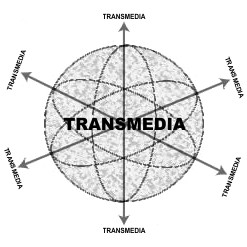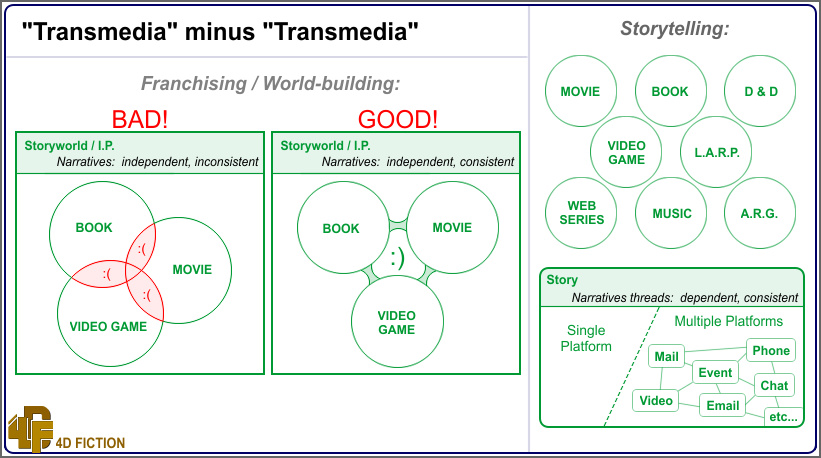(followup articles, links, and commentaries appended)
Can someone tell me what on earth “transmedia” means these days? As an ARG enthusiast, traditionalist, and one who’s previously done some developing behind the scenes, I’m here adding my voice to the antitransmedia chorus.
Back in “the day” (mere years ago), there were these things called “Alternate Reality Games”. I remember them – potentially amazing experiences that involved their audience, told engaging stories, presented puzzles and games that were fun and actually made sense within their contexts, and allowed players to search and discover. These things were also somewhat subversive – they never actually said they were fictional, but we all knew they were anyway.
Sometimes they’d tie in to a movie, and we ended up choosing to see it; or a video game, and we ended up choosing to play it. Or maybe they were just for fun, and we ended up making friends, forming communities.
Then word got out. Slowly, more people heard about them, and more and more people wanted to make them, to try new things, provide unique experiences. Then we saw variations that focused more on one thing than another, like the puzzles, or the narrative, or interaction, or centered on a specific platform. They came up with variations on names that would better describe those experiences.
As Jeff Watson stated recently in an article reflecting on ARGs and the issue of accurately labeling the entertainment genre:
The boundaries between gameplay and storytelling, single-platform and multi-platform, real and virtual, author and audience, are all disappearing as we speak. It’s all fiction. Someday we’ll just leave it at that.
But soon these things really started to go mainstream… discovered by the kind of people who wanted to ’embrace and extend’, as it were. Some wanted to claim a label for what they produced, some simply wanted to help define the genre by providing a more descriptive and accurate label. It came to the point that ARGs in the traditional sense were now a sort of sub-set of a quickly widening and muddying genre of storytelling and/or gaming and/or marketing. We now had what Sean Stacey termed “Chaotic Fiction” – chaos, indeed.
Here are a few sample terms adopted over recent years by creatives in this media space:
Alternate Reality Game, Reality Game, Alternate Reality Events, Chaotic Fiction, Connected Entertainment Product, Cross-Media Promotions and Distributed Narratives, Cross-platform Experiences, Entertainment Experience, Experience Design, Extended Reality, Full-Media Entertainment Experience, Immersive Brand Marketing, Innovative and Immersive Social Entertainment, Interactive Marketing Solutions, Media Integrated Gameplay, Participation Drama, Pervasive Media, Search Opera, Story Game…
…or even, as jested by Steve Peters – a “Pervasive Entertainment Experience” (PEE)
But the term that ultimately caught on was “transmedia storytelling”. Short and sweet, to the point. It took the experience that Alternate Reality Games had come to represent, and provided a name which was more flexible and wide reaching; more simplistic, and generally a friendlier term to throw around for new cross-platform media experiences. Henry Jenkins, author of Convergence Culture: Where Old and New Media Collide, defined it in his article Transmedia 101:
Transmedia storytelling represents a process where integral elements of a fiction get dispersed systematically across multiple delivery channels for the purpose of creating a unified and coordinated entertainment experience.
Well, what we’re discovering now is the effect that this definition has had by excluding a limited scope for an “experience”. What was once a single story told or game played out across multiple media platforms has mutated into this (now shortened) buzzword “transmedia” (which is an adjective, by the way – not a noun) wherein a storyworld containing many stories can be told or experienced across multiple platforms.
It seems like these days a lot of the “transmedia” attention is given to projects that really take place only on the web, as classic multimedia (audio, video, graphics, perhaps some social networking), and are generally promotional material for some new product within an existing IP, or franchise – thus, a component or extension of the greater experience that is the transmedia franchise. They may or may not tell a story. They may or may not be interactive. They may or may not even be fun.
Where’d the ARG go?
In 2010, the Producers Guild of America adopted the position “Transmedia Producer” into its vocabulary. Here, the PGA explicitly states:
A Transmedia Narrative project or franchise must consist of three (or more) narrative storylines existing within the same fictional universe on [multiple] platforms
A “Transmedia Narrative” now seems to support any experience – as long as it consists of multiple connected stories, and utilizing multiple media. …But is this not simply the making of a franchise?
The growing backlash at this diminishing of actual story-telling in lieu of franchise-developing is becoming apparent. In a random tweet that began a slew of responses in what could be called an anti-transmedia movement, Steve Peters of No Mimes Media demonstrated that there’s a quiet subset of people who really don’t prefer ‘transmedia’ as the defining term for what they do on the smaller, story-sized scale.
Gawd I’m learning to hate the term transmedia more and more. Pretentious, pompous, not fun or entertaining. There, I said it. :P
~Steve Peters
Even Felicia Day, an actress and the creator of the web series The Guild, which now spans and incorporates multiple media, had this to say on “transmedia” at a SXSW 2011 panel (or listen, in answer to a question at ~51mins: mp3/src):
It’s just a really stupid word, and people use it because they don’t know. I just hate it. What does it mean? It means nothing! Listen, transmedia is any comic book that ever became a movie before the internet. […] Anything is transmedia.
Dee Cook at Workbook Project even described the “transmedia” content at SXSW 2011 (where it was a boiling hot topic) in this way:
…the most overused and under-understood [term] of the conference… Most of the “Transmedia” panels just didn’t seem to get it – there was no takeaway, there was a lot of gobbeldygook, and in one bizarre case, there was a futurist who seemed to be discussing how in 6-10 years we will all be watching programmed television.
After SXSW, Steve went on in another series of ranting tweets (read the full exchange here):
Telling ONE story on multiple platforms is NOT the same as telling many stories in the same universe on multiple platforms… By that definition, the earliest example of Transmedia is the Bible: stories, live events, plays, meetups, music, swag…. and if that’s the case, Transmedia is NOT SOMETHING NEW at all!
Transmedia SHOULD mean ONE SINGLE story on multiple platforms, not MANY stories in the same story world on many platforms
Franchising is NOT Transmedia. It’s FRANCHISING
Indeed, ‘transmedia’ by its current definition is not providing anything new – or original. It’s been around, really, since the beginning of human history, both intentionally and unintentionally!
Let’s start with some comments on current entertainment, such as Mythbusters…
I’d argue that MYTHBUSTERS is a very successful non-fiction #transmedia property: tv, web, books, science kits…
~@fossen
We certainly can’t forget Star Wars! Or Indiana Jones!
So far, the most successful transmedia franchises have emerged when a single creator or creative unit maintains control over the franchise. Hollywood might well study the ways that Lucasfilm has managed and cultivated its Indiana Jones and Star Wars franchises.
~Henry Jenkins, MIT Technology Review, 2003
And He-Man! (Or any property with action figures!)
From the beginning they thought of stories as resources out of which they could create their own fantasies, as something which shifted into the hands of the audience once they had been produced and in turn as something which was expanded and remixed on the grassroots level. In that sense, the action figure is very much the harbinger of the transmedia movement.
~Henry Jenkins, He-Man and the Masters of Transmedia
Religion!
Rachel Wagner highlights several significant similarities between religion and transmedia, which are “complex, multimedia streaming worlds,” where, “a story is spread across multiple media platforms.” The central story-world is a key component of both transmedia and religion.
~drmeinstein.com, on Rachel Wagner’s “Making Belief: Transmedia and The Hunger For The Real”
The Bible!
For me, transmedia is more the choice of the author(s) for how his/her vision is experienced: it’s a means. Stories have been transmedia forever. The Bible, for example, has been made successful as a transmedia project, from its creation myth to its world-building, and to its re-imagining and further transmedia exploration in such stories as C.S. Lewis’s Narnia Chronicles.
~Howard Goldkrand, director DexterAnother, much older example of transmediation versus adaptation might be found in a somewhat unexpected place: the stained-glass windows of cathedrals. […] hymns, sermons, artifacts, and, perhaps most spectacularly, enormous stained-glass windows. Are these transmedia extensions? One might argue that since a parishioner could first experience the story of Genesis through a rose window, then Exodus through a sermon, then Leviticus through hymns, and then Deuteronomy through paintings, the Bible has always been a transmedia franchise
~Geoffrey A. Long, Transmedia Storytelling, 2007
Your Life!
The array of media tools through which to “present ourselves” is already ubiquitous, and constantly expanding. Social networks, personal blogs, microblogs, digital cameras, location-based social applications […] With every status update and photo upload and location check-in and “like” we click, we are producing an endless stream of new “entry points” into our personal narratives. […] In the digital age, transmedia isn’t simply the default for how we experience entertainment, it is how we experience the story of our lives.
~Jenka Gurfinkel, Your Life is a Transmedia Experience
By the current trending definition of “transmedia”, I believe it is safe to conclude that Everything is transmedia – Everyone is a transmedia property.
Your mom is Transmedia.
So really, what’s the point of “transmedia” if everything is transmedia anyway? What happened to the good old multi-platform-story?
In the essay “Do You Have A Big Stick“, Dr. Christy Dena clarifies this apparent polarization of transmedia productions, defining them as a “collection of mono-medium stories” (eg, a franchise), and a “collection of media that tells one story” (eg, an ARG).
Let’s get back to the basics.
“Transmedia” is not new, and it’s probably not going away. So we should encourage people once again to tell stories, to make compelling, entertaining, educational experiences that play out wherever people are at in their own lives (using whatever platforms and media they use regularly), or even better – make an effort to create experiences that encourage people to make the world a better place.
@GuyGonzales:
Most exciting aspect of transmedia is its focus on great storytelling over business models. Without good stories, there is no business.
Even marketers jumping on the transmedia bandwagon as the new shiny are focused on the power and value of a good story.
Just like legends or stories passed on through generations over a campfire, the best productions are the ones that focus on this. They’re successful in the long term not because of their business model or financial gain – marketing for a product is irrelevant and temporal! – but because the people who willingly immersed themselves in them chose to continue their legacy, because they loved the experience and wanted to continue to tell other people excitedly about it.
Bring back the Alternate Reality Game!
Thankfully, Adrian Hon from Six to Start provided a positive outlook and some insight into the “hype curve” at SXSW 2011 in his talk “Project 314: Putting the ‘Game’ back in ARGs“.
Additionally, the new Transmedia Artists Guild (TAG) is an advocacy group of experience developers and creatives who work in this media space. From the About page:
The explosion of the internet and mobile platforms have put tools of media creation into the hands of people that previously couldn’t reach a wide audience. Many have refocused from more traditional media channels to work in this new space. For lack of a better name, much of this work is being called “transmedia.”
The TAG forum is a great starting resource for those interested in producing transmedia experiences, to communicate and interact with passionate developers who create them both for a living and just for fun.
Now, all that said, I don’t mean to imply that anything developed under the “transmedia” umbrella lacks anything by default. There also have been a number of quality projects, entertainment properties, and marketing campaigns that have been executed recently, along with a number of great ARGs that have returned to the roots of the genre. And, I can personally accept and understand the use of “transmedia” as a term on the franchise level, if it’s indicated as much. I can grok Star Wars, Star Trek, The Matrix, and Halo as transmedia franchises. But I think we need to bring focus back on the story-telling experience moreso than the franchise developing.
In the end, the “transmedia” label itself has certainly helped creators and enthusiastic newcomers grasp the concept and importance of synergy across platforms within franchises, properties, and single stories, providing a standard for consistency and encouraging a strive for quality storytelling in our modern social media world.
And that’s a Good Thing.
Followup discussions:
Some other great articles posted, weighing in on this topic:
- Mar 21] Steve Peters: The Transmedia Hijack (or how Transmedia is the New Dihydrogen Monoxide)
- Mar 21] Nine Bargiel: I Am a Transmedia Producer
- Mar 21] Tara Tiger Brown: Transmedia: post 1 of 5
- Mar 22] Silverstring Media: Last Thing I’ll Say
- Mar 24] Brooke Thompson: Love It or Hate It… Defending Transmedia
- Mar 25] PlayThisNext: Transmedia Thinking
- Apr 25] Brooke Thompson: Transmedia is Killing Hollywood is Killing Transmedia
- Apr 26] Brooke Thompson: Rebooting Transmedia
- May 2] Brian Clark: Reclaiming Transmedia Storyteller
- May 18] Steve Peters: What the hell *is* Transmedia?
- May 18] Andrea Phillips: WTF is Transmedia?
Additional interesting articles that discuss transmedia development at various levels:
- Q&A with Matthew Cullen of Mirada on transmedia and storytelling at JWTIntelligence
- Allison Norrington at Wired UK: Transmedia Tales and the Future of Storytelling (2009)
Structural analyses:
- Stitch Media chimed in with what I think is a very appropriate and accurate diagram of what we are currently including in the “transmedia” discussion, one of the best and simplest I’ve seen so far:
- The above diagram inspired me to write a followup article providing an individual’s walkthrough of a transmedia production on this scale: Transmedia Storytelling: A sample experience
- Another excellent analysis of this media space was published by Rob Pratten at Workbook Project – Transmedia Storytelling: Getting Started (2010)
UPDATE April 11, 2011: I’ve created a diagram geared more towards the confusion that seems to be caused by the Producers Guild of America’s “Transmedia Producer” credit. As an attempt to visualize the distinctive qualities of different productions, this depicts much of the structural differences between transmedia on a single experience scale, and a franchise scale. (click to enlarge)
Another followup diagram I made illustrates the type of general creation in this media space, but without the vagueness of the “transmedia” term. (click to enlarge)
UPDATE May 2, 2011: Brian Clark of GMD Studios posted a response article (on Facebook) summing up much of the situation, confusion, and controversy in the discussion surrounding “transmedia” in the context of storytelling and franchise – read it here: “Reclaiming Transmedia Storyteller“. His article has spawned an immense discussion. (Facebook login required)
UPDATE May 18, 2011: Steve Peters of No Mimes Media once again chimed in with another effort at clarification and trying to understand this confounding debate about “Transmedia”, with “What the hell *is* Transmedia?“. He offers this definition of “transmedia storytelling”
Transmedia storytelling is telling a single story spread beginning-to-end across multiple platforms.





